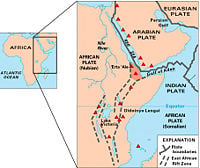Afar Depression

The Afar Depression (also called the Danakil Depression or the Afar Triangle) is a geological depression in the Horn of Africa, where it overlaps Eritrea, the Afar Region of Ethiopia, and Djibouti. Afar is well known as one of the cradles of hominids, containing the Middle Awash, site of many fossil hominid discoveries; Gona, site of the world's oldest stone tools; and Hadar, site of Lucy, the fossilized specimen of Australopithecus afarensis.
The Afar Depression includes the Danakil Desert and the lowest point in Africa, Lake Asal (–155 meters or –500 ft). Dallol is also part of the Depression, one of the hottest places year-round anywhere on Earth. The climate varies from around 25 °C (77 °F) during the rainy season (September–March) to 48 °C (118 °F) during the dry season (March–September). Only the Awash River flows into the depression, where it ends in a chain of lakes that increase in salinity.
Environment
The lowlands of the Afar Depression are dominated by heat and drought. There is no rain for most of the year, and yearly rainfall averages range from 100 to 200 millimetres (4 to 7 in), with less rain falling closer to the coast. The Awash River, flowing north-eastward through southern Afar, provides a narrow green belt and enables life for the flora and fauna in the area and for the Afars, the nomadic people living in the Danakil desert. About 128 kilometres (79 miles) from the Red Sea, the Awash ends in a chain of salt lakes, where its water evaporates as quickly as it is supplied. About 1200 km² (463 sq mi) of the Afar Depression is covered by salt, and salt mining is still a major source of income for many Afar tribes.
The Afar Depression biome is characterized as desert scrubland. Vegetation is mostly confined to drought-resistant plants such as small trees (e.g. species of the dragon tree), shrubs, and grasses. Wildlife includes many herbivores such as Grevy's Zebra, Soemmering’s Gazelle, Oryx Beisa and, notably, the last viable population of African wild ass (Equus africanus somalicus). Birds include the ostrich, the endemic Archer's lark (Heteromirafra archeri), the Secretary Bird, Arabian and Kori bustards, Abyssinian Roller and Crested Francolin. In the southern part of the plain, in Ethiopia, lies the Mille-Sardo Wildlife Reserve (established 1973). Many fossils have been found in the Awash region, not only hominids but also elephantoids, crocodiles and hippopotamus.
Geology
The Afar Depression results from the presence of a tectonic triple junction (the Afar Triple Junction) where the spreading ridges that are forming the Red Sea and the Gulf of Aden emerge on land and meet the East African Rift. The central meeting place for these three pieces of Earth's crust is around Lake Abbe. The Afar Depression is one of two places on Earth where a mid-ocean ridge can be studied on land, the other being Iceland.
In the Depression, the earth's crust is slowly rifting apart at a rate of 1–2 centimetres (0.3–0.8 in) per year along each of the three rifts which form the "legs" of the triple junction. The immediate consequence of this is that there are (as of late 2005) a continuous sequence of earthquakes, fissures hundreds of metres long and deep appearing in the ground, and the valley floor sinking as much as 100 metres. Between September and October 2005, 163 earthquakes of magnitudes greater than 3.9 and a volcanic eruption occurred within the Afar rift. 2.5 cubic kilometers of molten rock was injected into the plate along a dyke between depths of 2 and 9 km, forcing open an 8 meter wide gap on the surface.[1]
Over millions of years, geologists expect the Red Sea to erode through the highlands surrounding the Afar Depression and flood the valley. In about 10 million years, geologists predict that the whole 6,000 km length of the East African Rift will be submerged, forming a new sea as large as the Red Sea is now. At that point, Africa will have lost its horn.[2]
The floor of the Afar Depression is composed of lava, mostly basalt. One of Earth's great active volcanoes, Erta Ale, is found here. The Afar Depression is, in the views of some geologists, underlain by a mantle plume, a great upwelling of mantle that melts to yield basalt as it approaches the surface.
Notes
ReferencesISBN links support NWE through referral fees
- Alebachew Beyene and Mohamed G. Abdelsalam, 2005. "Tectonics of the Afar Depression: A review and synthesis." Journal of African Earth Sciences, Volume 41, Issues 1-2, pp 41-59
- Kloos, Helmut (1982) 'Development, drought and famine in the Awash valley of Ethiopia', African Studies Review, vol. 25, no. 4, p. 21-48.
- World Wildlife Fund (2001) 'Ethiopian xeric grasslands and shrublands (AT1305)' online version.
- Bojanowski, Axel, "Africa's New Ocean: A Continent Splits Apart", Spiegel Online, 2006-03-15. Retrieved 2006-03-16. Includes a photo essay of the region and its geologic changes.
External links
All Links Retrieved January 7, 2009.
- Photos of Erta Ale
- Hotsprings at Dallol
- The Ethiopian state of Afar: Topography and Climate
- (French) Photos of Afar Depression: between Ethiopia and Djibouti
Coordinates:
Credits
New World Encyclopedia writers and editors rewrote and completed the Wikipedia article in accordance with New World Encyclopedia standards. This article abides by terms of the Creative Commons CC-by-sa 3.0 License (CC-by-sa), which may be used and disseminated with proper attribution. Credit is due under the terms of this license that can reference both the New World Encyclopedia contributors and the selfless volunteer contributors of the Wikimedia Foundation. To cite this article click here for a list of acceptable citing formats.The history of earlier contributions by wikipedians is accessible to researchers here:
The history of this article since it was imported to New World Encyclopedia:
Note: Some restrictions may apply to use of individual images which are separately licensed.


